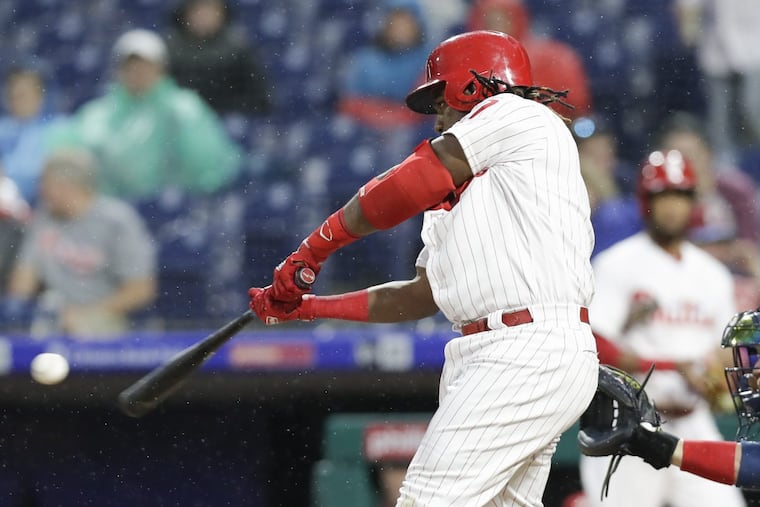Phillies hope Maikel Franco's power could be unlocked with one swing adjustment | Scott Lauber
Following a model that worked for slugger J.D. Martinez, Phillies hitting coach John Mallee is trying to get Maikel Franco to add loft to his swing and hit the ball in the air more frequently.

WASHINGTON — After getting hired by the Phillies in November, hitting coach John Mallee dove into data on the players with whom he would be working. And it didn't take long to draw a few conclusions about Maikel Franco.
"His exit velocity is really good," Mallee said the other day, "but his ground ball rate is too high."
Indeed, Franco hit the ball as hard as almost any of the Phillies last season with an average exit velocity of 88.9 mph, according to Statcast. But he also was among the team's most extreme ground ball hitters at 45.4 percent, second to leadoff man Cesar Hernandez (52.8). Franco doesn't have nearly Hernandez's speed, so the result was predictable: Too many balls on the ground, regardless of how quickly they came off the bat, led to too many outs, which led to a disappointing .230 average and .409 slugging percentage from a player whose power should make him a middle-of-the-order force.
Mallee studied the numbers further, then watched Franco in spring training. Then he decided the 25-year-old third baseman looked similar to a hitter he coached five years ago in Houston.
Franco reminded Mallee of J.D. Martinez.
Sounds crazy, right? Martinez is one of the most feared sluggers in baseball, while Franco is merely trying to prove he's good enough to be part of the next great Phillies team. But in 2013, Martinez's career sputtered. His OPS dropped from .742 in 2011 to .685 in 2012 and finally to .650 in 2013, after which the Astros removed him from the 40-man roster.
That's when Martinez made drastic changes. He went to see Craig Wallenbrock and Robert Van Scoyoc, Southern California-based coaches at the forefront of baseball's "launch angle" craze. Over the next few weeks, they got Martinez to drop his hands, alter his posture, and use his hips to get more loft on the ball. Most important, they changed his swing path to keep the bat in the hitting zone longer. Suddenly, Martinez was able to drive the ball in the air more regularly.
"He was a guy that, his concepts were off," Mallee said. "Change your concepts, change your swing."
That's what Mallee keeps telling Franco.
During their early work in the batting cage and in pregame video sessions, Mallee has been coaching Franco on adjusting what manager Gabe Kapler calls his "spine angle." The idea: If righty-swinging Franco is able to tilt his shoulders skyward and more toward left-center field, it might change his swing path and turn the balls that he's scorching on the ground to shortstop and third base into doubles and home runs.
"The positioning of his posture creates his [swing] path to be a little steep," Mallee said. "So when you adjust the spine angle and he gets into rotation, it allows the bat to turn under and get on plane with the pitch sooner and hopefully hit through the ball better and get more balls in the air."
Got all that?
It's not clear yet that Franco does. Through the end of the series in Miami this week, his average launch angle was still only 10.3 degrees, down slightly from 11.4 degrees last season. Most launch-angle afficionados believe 20-30 degrees is optimal. Rhys Hoskins leads the Phillies with an average launch angle of 21.5 degrees.
But there were positive signs. Franco was slugging .466 with nine extra-base hits, four of which had come in his previous five games. In his last eight games entering this weekend's series in Washington, he was 9 for 30 (.300) with a .567 slugging percentage.
None of this means Franco is the second coming of Martinez. But it might be an encouraging sign in what will prove to be the most critical season yet in Franco's development at a time when his salary jumped to $2.95 million through the arbitration system and will rise again next year.
"I've got a lot of power and I know that," Franco said. "I don't want to force the situation. I just want to get a lot of information that I think is going to help me a lot. That's what I'm going to try to do with [Mallee]. Whatever he says to give me the right information, I'm going to do it. I just want to feel comfortable."
Even if it takes a while.
"It's a process," Mallee said. "He's taken to the changes really quickly in his work, but I don't know if it's total habit yet in the game. It's just going to take repetitions. I think his power could really come if he just gets on a better plane with the pitch. And he's doing much better with it, so hopefully it will translate."
Franco's future may depend on it, just as Martinez's did five years ago.
Get insights on the Phillies delivered straight to your inbox with Extra Innings, our newsletter for Phillies fans by Matt Breen, Bob Brookover and Scott Lauber. Click here to sign up.